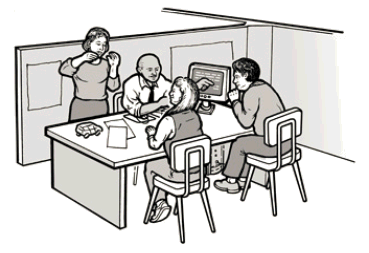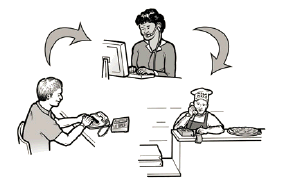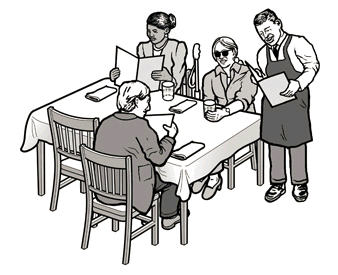Communicating with Customers
Communicating successfully with customers is an essential part of doing business. When dealing with customers who are blind or have low vision, those who are deaf or hard of hearing, or those who have speech disabilities, many business owners and employees are not sure what to do. The ADA requires businesses to take steps necessary to communicate effectively with customers with vision, hearing, and speech disabilities.
Because the nature of communications differs from business to business, the rules allow for flexibility in determining effective communication solutions. What is required to communicate effectively when discussing a mortgage application at a bank or buying an automobile at a car dealership will likely be very different from what is required to communicate effectively in a convenience store. The goal is to find practical solutions for communicating effectively with your customers. For example, if a person who is deaf is looking for a particular book at a bookstore, exchanging written notes with a sales clerk may be effective. Similarly, if that person is going to his or her doctor’s office for a flu shot, exchanging written notes would most likely be effective. However, if the visit’s purpose is to discuss cancer treatment options, effective communication would likely require a sign language or oral interpreter because of the nature, length, and complexity of the conversation. Providing an interpreter guarantees that both parties will understand what is being said. The revised regulations permit the use of new technologies including video remote interpreting (VRI), a service that allows businesses that have video conference equipment to access an interpreter at another location.

Exchange of written notes may be appropriate for casual interactions.
It is a business’s responsibility to provide a sign language, oral interpreter, or VRI service unless doing so in a particular situation would result in an undue burden, which means significant difficulty or expense. A business’s overall resources determine (rather than a comparison to the fees paid by the customer needing the interpreter) what constitutes an undue burden. If a specific communications method would be an undue burden, a business must provide an effective alternative if there is one.

Complex transactions will likely require more formal means of communication, such as a sign language interpreter.
Many individuals who are deaf or have other hearing or speech disabilities use either a text telephone (TTY) or text messaging instead of a standard telephone. The ADA established a free telephone relay network to enable these individuals to communicate with businesses and vice versa. When a person who uses such a device calls the relay service by dialing 7‒1‒1, a communications assistant calls the business and voices the caller’s typed message and then types the business’s response to the caller. Staff who answer the telephone must accept and treat relay calls just like other calls. The communications assistant will explain how the system works if necessary.

Businesses must answer calls placed through the telephone relay service.
The rules are also flexible for communicating effectively with customers who are blind or have low vision. For example, a restaurant can put its menu on an audio cassette or a waiter can read it to a patron. A sales clerk can find items and read their labels. In more complex transactions where a significant amount of printed information is involved, providing alternate formats will be necessary, unless doing so is an undue burden. For example, when a client who is blind visits his real estate agent to negotiate the sale of a house, all relevant documents should be provided in a format he can use, such as on a computer disk or audio cassette. It may be effective to e-mail an electronic version of the documents so the client can use his or her screen-reading technology to read them before making a decision or signing a contract. In this situation, since complex financial information is involved, simply reading the documents to the client will most likely not be effective. Usually a customer will tell you which format he or she needs. If not, it is appropriate to ask.

Reading a menu to a customer who is blind is one way to provide effective communication.

User Comments/Questions
Add Comment/Question